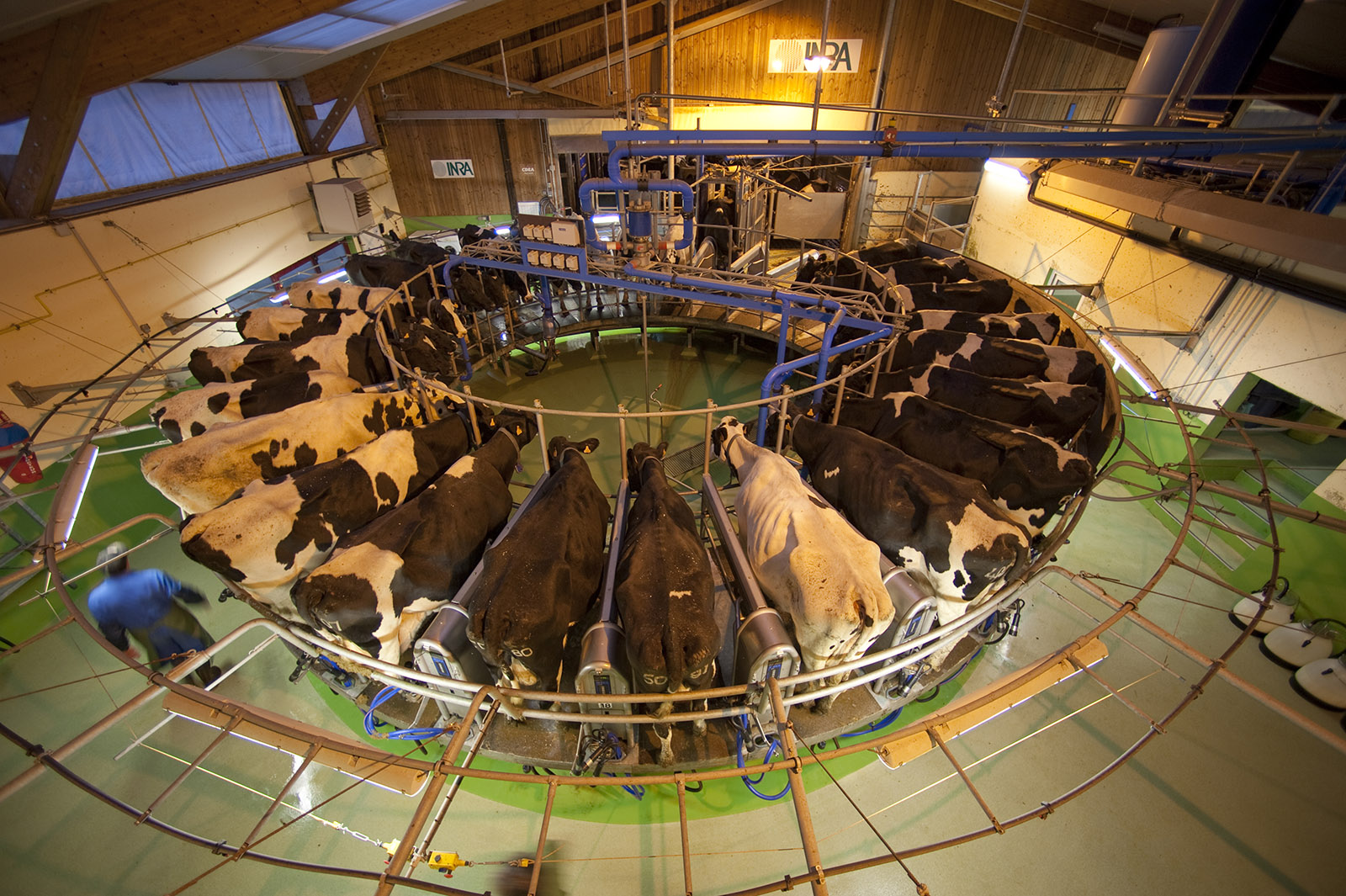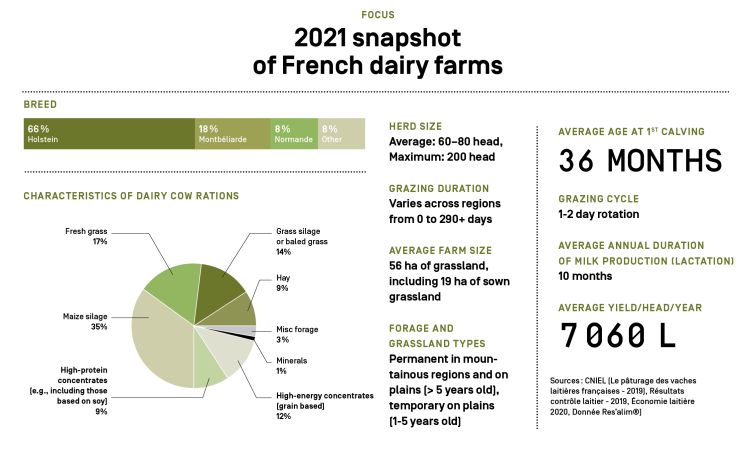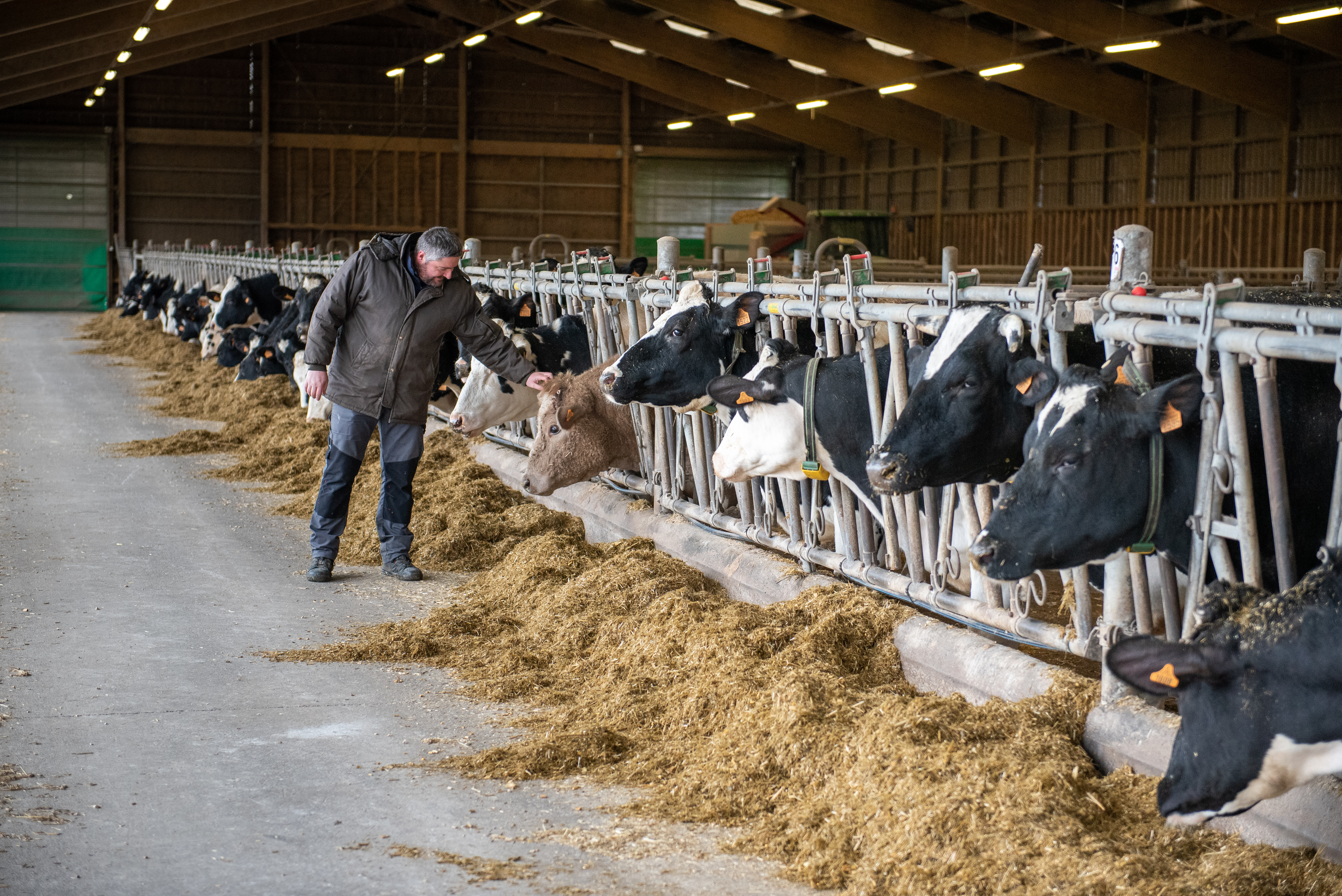Ressources dossier
AgroecologyDairy farming: current practices
Published on 19 January 2023
Humans have been consuming animal milk since mammals were first domesticated nearly 10,000 years ago. Regardless of its source, animal milk is rich in proteins, vitamins, minerals, and essential fatty acids, making it a nutritionally complete food. Around the world, people of all ages include milk in their diets. “According to the FAO, cow’s milk (from all breeds combined) volumetrically accounted for 81% of global milk production in 2019. Since World War II, production levels have increased significantly, thanks to advances in livestock genetics and feed quality. In 2020, a total of 850 billion litres was generated”, comments Vincent Chatellier, an economics researcher in the Structures and Markets in Agriculture, Resources and Territories Joint Research Unit (SMART, INRAE Centre of Brittany-Normandy). Milk is the starting point for the essential and diverse dairy products consumed by human populations, including liquid and powdered milk, yoghurt, cheese, butter, cream, and dairy desserts.

Three main production systems
Dairy farming takes on extremely different forms, including among regions within the same country. There are three main production systems, which differ based on how the animals are nourished: pastoral systems, mixed systems, and industrial systems. While animals mostly consume forage (60-80%) in all three systems, the source of this forage varies greatly and is determined by country geography, climate, and crop type. Farmers often use concentrates, which are formulated from grains, legumes, and oilseeds. While concentrates are most commonly purchased, they may also be prepared using a farm’s own crops.
Pastoral systems: highly localised
According to the 2014 Atlas de l’élevage herbivore, pastoral systems are responsible for 9% of global milk production (in litres; FAO figures from 2010). In these systems, cows consume a diet that is 90% fresh grass and hay. Pastoral systems are common in areas that are poorly suited to crop farming, such as mountain plateaus and non-arable lands (e.g., steppes, savannas). Livestock herds are shifted among pastures across seasons, giving the grass time to grow back. Pastoral farming is still used in many parts of the world, including in Europe, the Americas, Australia, Africa, and East Asia. The degree of movement varies, from nomadism in Africa to large-scale private ranching in North America to transhumance in Europe. In France, pastoral farming is largely found in high-elevation regions.
Mixed systems: the norm
Mixed production systems predominate across the globe.
Mixed systems predominate across the globe as they represent 81% of all production systems. However, they exist in highly diverse forms. Mixed systems have grasslands for livestock grazing and fields for producing crops intended for consumption by humans or livestock (e.g., grains, oilseeds, legumes). Livestock manure is then used as crop fertiliser. Farmers may use concentrates to increase milk yields per animal, ensuring consistent production throughout the year. “Mixed systems are, by far, the most common system type in Europe. However, there is variation in the relative consumption of different grass types (e.g., fresh grass, silage, baled silage). Such systems occur throughout France, on both plains and piedmont slopes”, explains Jean-Louis Peyraud, special adviser at INRAE's Scientific Directorate for Agriculture and researcher in the domain of animal production.
Industrial systems are concentrated in China and the US
Industrial systems are responsible for less than 10% of global milk production (in litres). Livestock are largely fed using concentrates (90%), although some forage is provided as well. These systems are also sometimes described as using "off-soil production” because they have become untethered from land-based, farming resources. Industrial dairy farming first emerged in the 1960s, as a response to increasing demand. On the global scale, examples include dairy feed lots in the US and China, which host tens of thousands of cows, and intensive dairy farms in Israel, which contain smaller numbers of animals that generate extremely high individual yields (15,000 litres/year). “In Europe”, remarks Jean-Louis Peyraud, “industrial systems remain rare. It is more cost effective to produce forage than to bring it in from off site, given transportation costs.”
The role of Europe
In Europe, grazing is in decline as farmers switch to conserved forage.
Around the world, milk is produced via three main systems, whose degree of profitability is shaped by geographical, climatic, and political constraints and opportunities. “Tremendous diversity can be found in the European Union (EU-27), which produces more milk than either the US or India. EU production levels reached 151.3 billion litres per year in 2018”, notes Vincent Chatellier. Almost all of the 438,000 cattle dairy farms found in Europe are family establishments that use mixed systems.
Jean-Louis Peyraud comments: “Herd size differs among countries. Some major dairy producers, such as France, Ireland, and the Netherlands, have opted for medium-sized herds of around 60 to 80 cows. Others have gone for larger herds. For example, in Denmark, herds tend to exceed 150 to 200 cows. Germany has herds of over a thousand head.” Yields vary across countries, from 3,200 litres/cow in Romania to 9,500 litres/cow in Denmark.
While the surface area dedicated to farmland is stable or even growing in EU countries, levels of grazing are in decline. Farms are switching to conserved forage that is produced on site.

Intensive or extensive? Defining important terms

When we talk about intensive dairy farming, are we referring to milk yield per animal or per hectare of resources? The definition we use makes a difference when assessing impacts on the environment and animal welfare.
“Intensive farming may involve situations with a high target yield per cow (>12,000 litres per year), where the animals live indoors in large herds that have no access to pastures”, explains Jean-Louis Peyraud, special adviser at INRAE's Scientific Directorate for Agriculture. That said, certain grass-based systems can also be intensive. For example, New Zealand has dairy herds that number around 400-1,000 head (source: IFCN Dairy Report 2020). They graze on grasslands maintained via very high levels of irrigation, “yet milk production per cow remains moderate, around 6,000 litres/year”, remarks Jean-Louis Peyraud. In contrast, extensive farming aims to limit inputs (e.g., fuel oil, forage, feed) and better balances herd density and grassland production potential. Grasslands can be cut and harvested to provide fodder to livestock kept in enclosures, as occurs on some organically certified farms in Denmark. Production systems could be more readily compared by examining the relative balance between animal density and farm resources (e.g., hectares of pasture, forage, and fertilised land or ecosystem diversity). ●
-
Sarah-Louise Filleux
(Send email)
Author / Translated by Jessica Pearce
Direction de la communication
